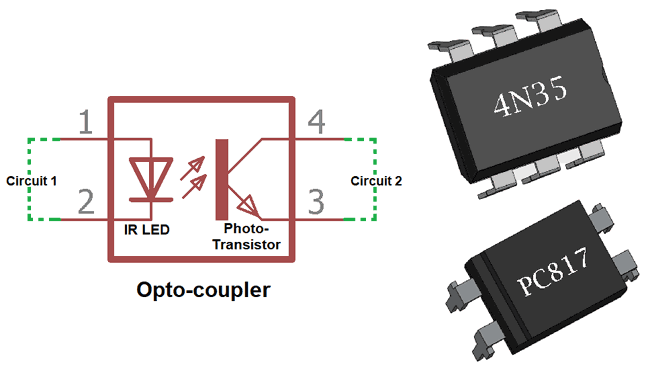
Opto-coupler is an electronic component that transfers electrical signals between two isolated circuits. Optocoupler also called Opto-isolator, photo coupler or optical isolator.
Often in circuits, especially low voltage or highly noise sensitive circuits, Optocoupler is used to isolate circuitry to prevent electrical collision chances or to exclude unwanted noises. In present commercial market, we can buy Opto-coupler with 10 kV to 20 kV input to output withstand voltage capacity, with a specification of 25 kV / uS voltage transients.
Internal Structure of Optocoupler
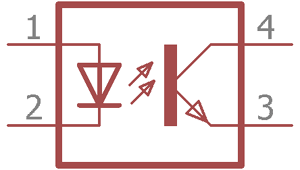
This the internal structure of the opto-coupler. On the left side pin 1 and pin 2 are exposed, it is a LED (Light Emitting Diode), the LED emit infrared light to the photosensitive transistor on the right side. The photo-transistor switches the output circuitry by its collector and emitter, same as typical BJT transistors. Intensity of the LED directly controls the photo-transistor. Since the LED can be controlled by a different circuitry and the photo transistor can control different circuitry so two independent circuits can be controlled by Optocoupler. Also, between the photo-transistor and the Infrared LED, the space is transparent and non-conductive material; it is electrically isolating two different circuits. The hollowed space between LED and photo-transistor can be made using Glass, air, or a transparent plastic, the electrical isolation is much higher, typically 10 kV or higher.
Types of Optocouplers
There are many different types of Optocouplers are available commercially based on their needs and switching capabilities. Depending on the use there are mainly four types of optocouplers are available.
- Opto-coupler which use Photo Transistor.
- Opto-coupler which use Photo Darlington Transistor.
- Opto-coupler which use Photo TRIAC.
- Opto-coupler which use Photo SCR.
Photo-Transistor Optocoupler

In the upper image the internal construction is shown inside a Photo-transistor Optocoupler. The Transistor type can be anything whether PNP or NPN.
Photo-Transistor can be further of two types depending on the output pin availability. On the second image on the left, there is additional pin out which is internally connected with transistor’s base. This pin 6 is used to control the sensitivity of the photo-transistor. Often the pin is used to connect with ground or negative using a high value resistor. In this configuration, false triggering due to noise or electrical transients can be controlled effectively.
Also, before using Photo-transistor based optocoupler, the user must know the maximum rating of the transistor. PC816, PC817, LTV817, K847PH are few widely used photo-transistor based optocoupler. Photo – Transistor based opto-coupler is used in DC circuit related isolation.
Photo-Darlington Transistor Optocoupler

In the upper image there are two types of symbol, internal construction of Photo-Darlington based opto-coupler is shown.
Darlington Transistor is two transistor pair, where one transistor controls other transistor base. In this configuration the Darlington Transistor provide high gain ability. As usual the LED emits infrared led and controls the base of the pair transistor.
This type of opto-coupler also used in DC circuit related area for the isolation. The 6th pin which is internally connected to the base of the transistor, used to control the sensitivity of the transistor as discussed previously in photo-transistor description. 4N32, 4N33, H21B1, H21B2, H21B3 are few photo-Darlington based opto-coupler example.
Photo-TRIAC Optocoupler
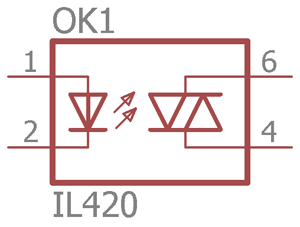
In the upper image the internal construction or the TRIAC based opto-coupler is shown.
TRIAC is mainly used where AC based control or switching is needed. The led can be controlled using DC, and the TRIAC used to control AC. Opto-coupler provide excellent isolation in this case too. Here is one Triac Application. The photo-TRIAC based opto-coupler examples areIL420, 4N35 etc are example of TRIAC based opto-coupler.
Photo-SCR based Optocoupler
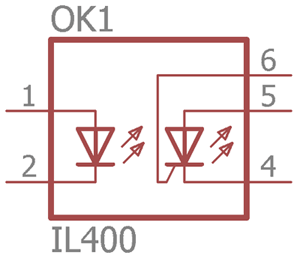
SCR stand for Silicon controlled rectifier, SCR also referred as Thyristor. In the upper image a Photo-SCR based opto-coupler’s internal construction is shown. Same as like other opto-coupler the LED emit Infrared. The SCR is controlled by the intensity of the LED. Photo-SCR based Opto-coupler used in AC related circuitry. Learn more about Thyristor here.
Few Examples of photo-SCR based opto-couplers are:- MOC3071, IL400, MOC3072 etc.
Applications of Optocoupler
As discussed before few Optocoupler used in DC circuit and few Optocoupler used in AC related operations. As the Optocoupler does not allow direct electrical connection between two sides, the main application of the Optocoupler is to isolate two circuits.
From switching other application, same as like where transistor can be used to switch application the Optocoupler can be used. It can be used in various microcontroller related operations where digital pulses or analog information needed from a high voltage circuitry, Optocoupler can be used for excellent isolation between this two.
Opto-coupler can be used for AC detection, DC control related operations. Let’s see few applications of Opto-transistors.
Optocoupler for Switching DC Circuit:
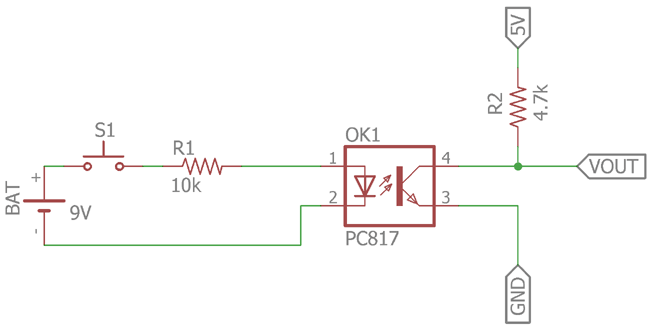
In the upper circuit a Photo-Transistor based optocoupler circuit is used. It will act like a typical Transistor switch. In the schematic a low cost photo-transistor based opto-coupler PC817 is used. The infra-red led will be controlled by the S1 switch. When the switch will be on, the 9V battery source will provide current to the LED via the current limiting resistor 10k.The intensity is controlled by the R1 resistor. If we change the value and make the resistance lower, the intensity of the led will be high making the transistor gain high.
On the other side the transistor is a photo-transistor controlled by the internal infra-red led, when the led emit infra-red light the photo transistor will contact and the VOUT will be 0 turning off the load connected across it. It is needed to remember that as per the datasheet the collector current of the transistor is 50mA. The R2 provide the VOUT 5v. The R2 is a pull-up resistor.
You can see the switching of a LED using opto-coupler in the below video…
In this configuration the photo-transistor based opto-coupler can be used with the microcontroller for detecting pulses or interrupt.
Optocoupler for Detecting AC Voltage:

Here another circuit is shown to detect the AC voltage. The infra-red led is controlled using two 100k resistor. The two 100k resistor used instead of one 200k resistor is for extra safety for short-circuit related condition. The LED is connected across wall outlet Line (L) & Neutral line (N). When the S1 is pressed the led start to emit infra-red light. The photo transistor makes a response and converts the VOUT from 5V to 0V.
In this configuration the opto-coupler can be connected across low voltage circuit such as microcontroller unit where the AC voltage detection is required. The output will produce square High to Low pulse.
As of now the first circuit is used to control or switching the DC circuit and second is to detect the AC circuit and control or switch DC circuit. Next we will see controlling AC circuit using DC circuit.
Optocoupler for Controlling AC Circuit using DC voltage:

In the upper circuit The LED is again controlled by 9V battery through 10k resistor and the state of the switch. On the other side a photo-TRIAC based opto-coupler is used, which control the AC LAMP from the 220V AC outlet. The 68R resistor is used to Control the BT136 TRIAC which is controlled by the photo-TRIAC inside the opto-coupler unit.
This type of configuration is used to control electrical appliances using low voltage circuitry. The IL420 is used in the upper schematic which is a photo-TRIAC based Opto-coupler.
Other than this type of circuitry an opto-coupler can be used in SMPS to sending secondary side short-circuit or over current condition information to the primary side.
If you want to see Optocoupler IC in real action, check below circuits:







Satisfy of understanding how Optocoupler works.